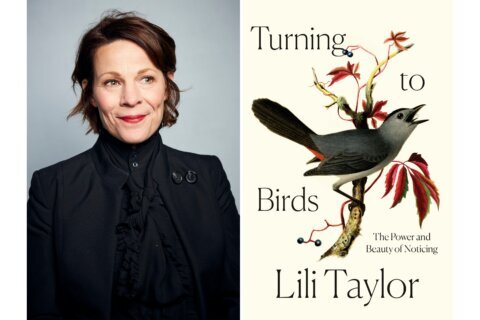If you grew up a child of the ’80s and ’90s, before you graduated to the mastery of Stephen King novels, your source of spooky campfire stories came from either R.L. Stine’s “Goosebumps” or Alvin Schwartz’s “Scary Stories to Tell in the Dark.”
The short story collections gave kids nightmares across a trilogy of publications: “Scary Stories to Tell in the Dark” (1981), “More Scary Stories to Tell in the Dark” (1984) and finally “Scary Stories 3: More Tales to Chill Your Bones” (1991).
Now, the series gets the big-screen treatment in “Scary Stories to Tell in the Dark,” a PG-13 adaptation that delivers intermittent frights amid plenty of campy nostalgia as it tries to stitch together unrelated spooky stories with mixed results. One can’t help but think that it would have been better as an episodic TV series.
Set in Mill Valley, Pennsylvania, on Halloween 1968, the story follows a group of teenagers: aspiring writer Stella (Zoe Colletti), her friends Auggie (Gabriel Rush) and Chuck (Austin Zajur), Chuck’s sister Ruth (Natalie Ganzhorn) and a drifter named Ramón (Michael Garza). Together, they explore the haunted house of the Bellows, whose daughter Sarah wrote a book of scary stories that come to life.
Like “Stranger Things” (2016) and “It” (2017), such a concept lives and dies on the camaraderie of its young cast. Colletti is sympathetic enough as the freckled, bespectacled leader with guts; Zajur’s Chuck is self-deprecating in his botched Spider-Man costume; Rush’s Auggie looks like a young Adam Scott; and Garza’s Ramón feels like this generation’s Sal Mineo in “Rebel Without a Cause” (1955).
Fittingly, we first meet Ramón hanging out at a drive-in theater showing “Night of the Living Dead” (1968), which saw an African-American survive the zombies, only to be shot and killed by police. Similarly, Ramón is called a slur who is “not from around here,” reminding us of the racism of 1968 in relation to 2019.
Likewise, there’s additional social commentary woven in circa 1968, mostly involving the Vietnam War, which plays out on television with presidential footage transitioning from LBJ to Nixon. If you don’t remember draft dodging in the books, you’d be right, but points for the attempt to layer the story with meaning.
Of course, all of this is in service of jump scares, which is the real reason you’re coming to see this movie. Fans of the books will remember several famous figures from Stephen Gammell’s illustrations, including Harold the Scarecrow (Mark Steger), the Toe Monster (Javier Botet), Jangly Man (Troy James with a voice by Andrew Jackson) and, scariest of all, the Pale Lady (also Steger).
The lattermost shows the directing chops of Norwegian filmmaker André Øvredal (“Trollhunter”), who crafts a truly freaky sequence with flashing red lights in labyrinthian hallways as a creepy creature approaches from all directions. No matter where way the victim turns, the grinning blob is always there, closing in on us in terror with an eerie score by Marco Beltrami (“Scream,” “A Quiet Place”).
While these individual segments are quite impressive, the sum of the parts is greater than the whole. That is to say, the individual stories are better as self-contained book chapters than cobbled together in a forced framing device. It would be like trying to tie every “Black Mirror” episode into one large story.
Thus, while it’s cool watching the stories magically appear written in blood, they feel like random developments if you didn’t read the source material as a kid. In the movie, each scary story is a bad omen for what’s about to happen, creating an air of inevitability that lowers the stakes for characters who can’t escape their final destination. As Stella says, “You don’t read the book, the book reads you.”
Any film that has this many writers suggests a surplus of input. Dan and Kevin Hageman (“Hotel Transylvania”) get chief writing credits, while Marcus Dunstan and Patrick Melton share story credits with Guillermo del Toro (“Pan’s Labyrinth”), who was originally set to direct the film (damn!) but settled for producer instead.
As a result, certain characters feel under explored. Lorraine Toussaint (“Selma”) doesn’t get enough to do as the town sage; Austin Abrams (“The Walking Dead”) is a cliche bully (not all jocks are jerks, folks); and Dean Norris (“Breaking Bad”) makes an emotional phone call as Stella’s cop father but doesn’t factor into the plot as much as his police chief (Gil Bellows, “The Shawshank Redemption”).
Even some of the main characters are left hanging. Are they dead? Alive? Somewhere in between? Just before the end credits, a narrator teases the possibility of resurrecting the victims, but it doesn’t say how. The goal is likely to leave it open to a sequel, but it feels like unnecessary dangling threads for anyone who actually cared about the group of teens. Let the dead rest in peace.
Alas, it becomes a standard teen horror movie, no more, no less. If you set your expectations at that level, you might just have a frightful good time. Just don’t go throwing out your books in favor of the film. If this movie adaptation proves anything it’s that the books will always have a special place on your shelf.









